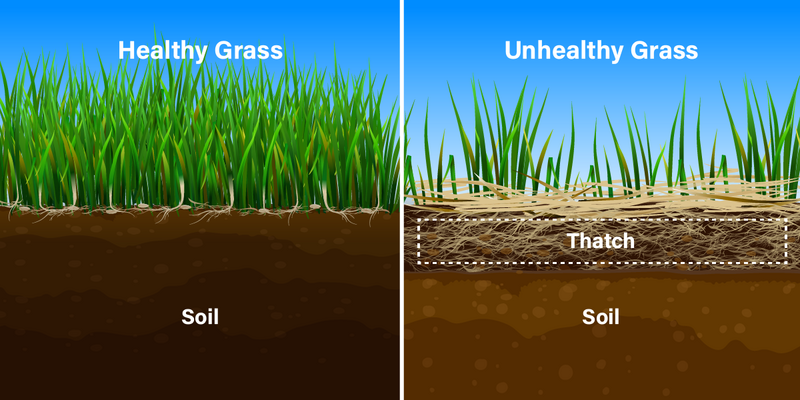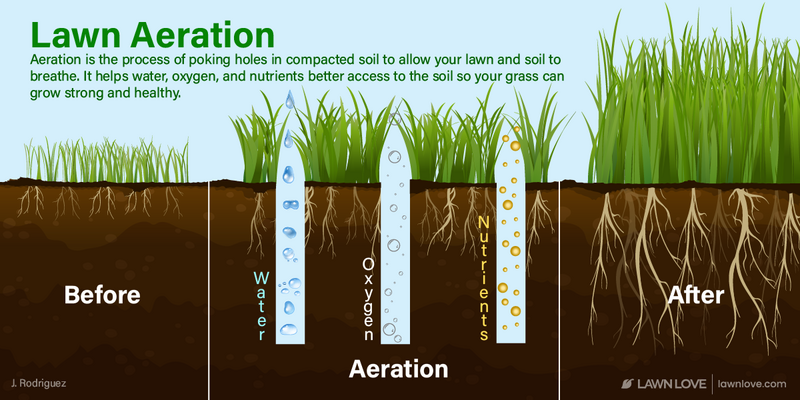How To Fix A Waterlogged Yard

Is constant rain bogging down your lawn? That much water can do a lot of impairment to your grass. This guide is here to help you place and solve some of the near mutual wet lawn problems, plus improve the drainage in your thousand so y'all never face these problems again.
6 mutual lawn issues caused by moisture grass (and how to fix them)
Your grass needs some water, but if you see puddles in your lawn for days subsequently every rainstorm, that's likewise much moisture for good for you grass. These are the problems to look out for in your waterlogged lawn.
1. Pest infestations
Many insect pests thrive in moisture atmospheric condition, and a waterlogged lawn provides the perfect dwelling house for them.
Overly wet grass and soil will probably attract some of these mutual pests:
- Mosquitoes: flight parasites that cause skin irritation with their bites
- Fleas: biting, jumping little bugs that motion from the lawn onto your pets
- Grubs: worm-like beetle larvae that feed on grassroots
- Leatherjackets: maggots of crane flies that feed on grassroots, leaves, and crowns
- Termites: wood-tiresome insects that can infest your home'south structure
- Carpenter ants: forest-boring ants that can infest your abode's structure, like termites
How to get rid of backyard pests: Apply insecticides or natural pest control treatments such as beneficial nematodes to the lawn. For a longer-lasting approach, attract or introduce natural insect predators to feed on the pests, including but not express to birds, frogs, lizards, dragonflies, or spiders.
2. Fungal diseases
Backyard diseases infect and impale your grass, and nearly of them are acquired by fungi. Those fungi grow well in dampness, and then wet grass is a breeding ground for them.
Common lawn diseases caused past too much wet:
- Brownish patch: irregular patches of brown or yellowing grass
- Leaf spot/melting out: straw-colored or brown spots on grass blades
- Powdery mildew: white, mold-like growth on grass blades
- Ruby thread: wispy strands of pink or ruby growing on grass tips
How to get rid of backyard fungus: Utilise fungicides to the infected areas of your lawn.
3. Weeds
When there's excess water in your soil, weeds don't take to compete with the grass for resources considering there'south plenty to go around. If your lawn stays wet for a long time, you'll probably start seeing more weeds in your yard than usual.
How to get rid of weeds: Pull weeds by hand (roots and all) or apply post-emergent herbicides to kill existing weeds. If you lot don't have weeds still just expect them, apply pre-emergent herbicides to preclude them in the offset place.
4. Soil erosion
Soil erosion is what happens when lots of rain washes abroad your topsoil. Topsoil is where plants have root and soak upwardly their nutrients. In a spot without topsoil, you lot won't be able to grow grass or plants successfully.
Erosion is typically at its worst on slopes, where the soil can easily slide downhill. Thin and patchy lawns too tend to have more issues with erosion. Dumbo, good for you lawns are improve at holding on to their soil.
How to prevent erosion: If you have a sloped yard, intermission upwards the slope with terraces or retaining walls to keep information technology from eroding. Deep-rooted trees and plants prevent erosion, as well.
5. Nutrient-deficient grass
Excess water in your soil cuts off the grass's access to oxygen, causes plant nutrients to leach out of the soil, and amercement root hairs so grass can't absorb the nutrients anyway. With a lack of nutrients, your grass will grow weak and may plow yellow or chocolate-brown.
How to fix nutrient-scarce grass: Once you've solved your yard's drainage bug, and your lawn is relatively dry again, add compost and/or fertilizer to furnish your soil's nutrient supply.
6. Ineffective lawn treatments
While your lawn is however soaking moisture, the treatments that would usually help it – such every bit fertilizers, weed command products, pesticides, or fungicides – might not practise much at all. The water will wash these products away before they take a chance to soak into the soil.
How to make lawn treatments work again: Before you can effectively treat your lawn, yous'll need to correct drainage issues in your yard to assistance the grass dry out. We'll go over ways to practice that in the adjacent section.
How to prevent wet grass in the future
You can treat the issues acquired by a wet lawn as they arise, only those are the symptoms, not the cause. If you desire to eliminate the same issues for good, yous have to amend the drainage in your lawn so it doesn't get waterlogged again.
Hither are some means to solve drainage issues, starting with the easiest and moving on to the more drastic.
Clean your gutters
Fixing your yard's abiding sogginess might exist as uncomplicated every bit clearing out your gutters. When your gutters go chock-full with leaves, dirt, and other debris, they overflow and dump water over their sides. Instead of flowing through the downspout to the appropriate spot, that rainwater ends upward flooding your lawn.
Cleaning your gutters might be gross, only it's pretty piece of cake. Just gear up a sturdy ladder and scoop out the droppings by paw (with waterproof gloves) or with a minor mitt tool. Clean your gutters at least twice a twelvemonth to go along them from getting chock-full.
Dethatch

Thatch is a layer of dead grass clippings and other droppings that builds up on top of your soil over fourth dimension. Excessive thatch (thicker than ¾-inch) can cake water'south access to the soil and make your lawn drain slowly after rain. Removing the thatch, aka dethatching, clears up the pathways to your soil and improves drainage.
Dethatch your lawn using a manual dethatcher, power rake, or vertical mower. All these tools are designed to dig into the thatch layer and pull it up. After dethatching, you'll need to collect the debris from your lawn and either dispose of it or compost it.
Aerate

After dethatching, yous can aerate your lawn to improve soil drainage even more. Aeration is the procedure of punching holes a few inches into the soil to gear up soil compaction. Compacted soil is soil without any air pockets. Water (and oxygen and constitute nutrients) demand those air pockets to move freely through the soil and drain properly.
If you take a modest backyard, you can use a manual lawn aerator, which looks sort of like a pitchfork with sharp tines at the end that poke into the soil. You could too buy lawn aerating spikes that attach to the bottom of your shoes, so all you have to practice to aerate is walk across the lawn.
For larger lawns, you lot'll have an easier time if you purchase or rent a larger core aeration auto.
Add together soil amendments
Your soil may be naturally heavy and compacted, specially if it contains a lot of dirt. Heavy clay soils retain water for a long time. If your soil is already full of h2o, it can't absorb any more after pelting. For better drainage, you may need to lighten up your heavy soil with sure soil amendments.
Some soil amendments that help amend drainage include:
- Compost
- Expanded shale
- Finely shredded bark
- Composted wood fries
- Perlite
- Gypsum
For some amendments, you can spread them on top of your backyard and work them into the soil with a rake. Other amendments demand to be mixed with the soil several inches deep, so you have to dig downward into the soil, work in the material, and and then constitute sod or grass seed on top.
Thin out trees
Water tends to hang around longer in shady areas, where there'south no direct sunlight to evaporate information technology. Prune your trees, cutting dorsum and removing branches to sparse out the shade coverage on your grass. Then, more sunshine can become through and evaporate more h2o.
Install a drainage system
If you take all these measures and your lawn notwithstanding floods, consider installing a drainage system. A new drainage system will direct rainwater away from your backyard and into a storm bleed, dry well, or somewhere else information technology won't practice any harm.
Grand drainage solutions include:
- French bleed: A perforated pipe in a sloped trench covered in gravel that collects rainwater and carries it downhill to an appropriate collection signal
- Rain garden: Deep-rooted plants in a low bespeak of your lawn that absorb and filter rainwater; perfect if water tends to pool in ane specific spot on your backyard
- Dry creek bed: A trench filled with stones that prevents water runoff and erosion
Installing a drainage system for your m is an involved project that requires time, effort, and investment. It isn't necessary for all yards, but if your area has constantly wet weather, a system like the ones listed above can keep your lawn from turning into a swamp.
Regrade the lawn
In some cases, the problem is the shape of the yard. The way your backyard is sloped might crusade water to run downhill and puddle in a certain area. Yous tin can change the shape of your thou past regrading, which basically means moving big amounts of dirt to change the level and slope.
If you think you demand to regrade your lawn, you'll likely have to hire a professional with the equipment and knowledge necessary for such a big endeavor. This could be quite expensive, and then it should be a terminal resort.
FAQ about wet lawn problems
1. Why is my lawn e'er wet?
The nearly common reasons for a waterlogged lawn are heavy soil, poor drainage, an unfortunate slope of the thou, or not plenty sunlight. Detect methods to fix all these issues detailed higher up.
ii. Is information technology OK to mow wet grass?
If possible, never mow moisture grass. Mowing the backyard while it'south wet can hurt your grass, your mower, and even you lot.
3. How do you mow the lawn when it's wet?
If you have to mow the lawn moisture considering the rain just won't finish, follow these guidelines to cause the least damage possible:
—Don't mow when at that place are pools of continuing water. Look until the grass has dried at least a little flake.
—Avoid heavy riding mowers and use a push mower instead.
—Sharpen the mower blades and so they have a better risk of cutting the wet grass.
—Heighten the mowing deck every bit loftier as possible to reduce clumps of wet grass clippings.
—Don't endeavour to mulch or bag grass clippings, equally neither of these features work well with wet grass.
—Take breaks to clean the underside of the mower equally yous go to minimize the amount of droppings that sticks to it.
All-time watering practices for a healthy backyard
Rain isn't the only culprit that tin cause a waterlogged lawn. You might exist overwatering, which can cause yet issues as rain. In nearly cases, overwatering is actually worse than underwatering.
Larn the right manner to h2o your lawn and then it'southward never as well moisture or too dry. For best results, your lawn should get most one inch of water per calendar week, preferably in the morning (although you tin't control what time it rains).
One time your backyard is dry and healthy, Backyard Love's local backyard intendance pros tin can go along information technology that way with lawn mowing, aeration, fertilizing, weed control, and other services.
Primary Photo Credit: Nikolay Zakharov | Unsplash
Jordan Ardoin
Jordan Ardoin is a writer and indoor plant enthusiast hailing from Florida. In her spare time, she enjoys chasing her two cats around the house and trying to keep her houseplants alive.
How To Fix A Waterlogged Yard,
Source: https://lawnlove.com/blog/wet-lawn-problems/
Posted by: daleybeirch.blogspot.com


0 Response to "How To Fix A Waterlogged Yard"
Post a Comment